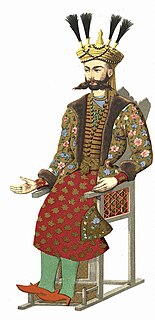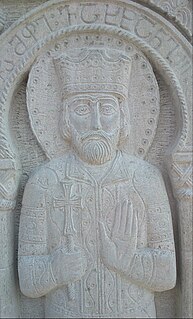 W
WAlexander I the Great, of the Bagrationi house, was king of Georgia from 1412 to 1442. Despite his efforts to restore the country from the ruins left by the Turco-Mongol warlord Timur's invasions, Georgia never recovered and faced the inevitable fragmentation that was followed by a long period of stagnation. Alexander was the last ruler of a united Georgia which was relatively free from foreign domination. In 1442, he abdicated the throne and retired to a monastery.
 W
WBagrat III, of the Georgian Bagrationi dynasty, was King of Abkhazia from 978 on and King of Georgia from 1008 on. He united these two titles by dynastic inheritance and, through conquest and diplomacy, added more lands to his realm, effectively becoming the first king of the Kingdom of Georgia. Before Bagrat was crowned as king, he had also reigned in Kartli as co-ruler with his father Gurgen from 976 to 978.
 W
WBagrat IV, of the Bagrationi dynasty, was the King of Georgia from 1027 to 1072. During his long and eventful reign, Bagrat sought to repress the great nobility and to secure Georgia's sovereignty from the Byzantine and Seljuqid empires. In a series of intermingled conflicts, Bagrat succeeded in defeating his most powerful vassals and rivals of the Liparitid family, bringing several feudal enclaves under his control, and reducing the kings of Lorri and Kakheti, as well as the emir of Tbilisi to vassalage. Like many medieval Caucasian rulers, he bore several Byzantine titles, particularly those of nobelissimos, curopalates, and sebastos.
 W
WConstantine I was King of Georgia from 1405 or 1407 until his death in 1412. He is the common ancestor of all surviving branches of the Bagrationi dynasty.
 W
WConstantine II, of the Bagrationi dynasty, was a king of Georgia since 1478. Early in the 1490s, he had to recognise the independence of his rival rulers of Imereti and Kakheti, and to confine his power to Kartli. In 1505, Constantine II died, and was succeeded by his son David X.
 W
WDavid IV, also known as David the Builder, of the Bagrationi dynasty, was a king of Georgia from 1089 until his death in 1125.
 W
WDavid VI Narin (1225–1293), from the Bagrationi dynasty, was king of Georgia in 1245–1293. From 1259 to 1293, he ruled the kingdom of Imereti under the name David I as a vassal state of Georgia.
 W
WDavid VII, also known as David Ulu (1215–1270), from the Bagrationi dynasty, was king of Georgia from 1247 to 1270, jointly with his namesake cousin, David VI, from 1247 to 1259, when David VI, revolting from the Mongol hegemony, seceded in the western moiety of the kingdom, while David VII was relegated to the rule of eastern Georgia. During his reign, Georgia went into further decline under the Mongol overlordship.
 W
WThe family of David IV the Builder, King of Georgia, was part of the Bagrationi dynasty. The dynasty had made their appearance in the Georgian lands in the 8th century and succeeded in unifying several native polities into a unified kingdom by 1008. David IV concluded this process of unification, setting stage for a Georgian domination in the Caucasus.
 W
WDavid Soslan was a prince from Alania and second husband of Queen Tamar, whom he married in c. 1189. He is chiefly known for his military exploits during Georgia's wars against its Muslim neighbors.
 W
WDemetrius I, from the Bagrationi dynasty, was King of Georgia from 1125 to 1156. He is also known as a poet.
 W
WDemetrius II the Self-Sacrificer or the Devoted of the Bagrationi dynasty, was king of Georgia in 1270–1289.
 W
WDemetrius was the second son of King Alexander I of Georgia by his first wife Dulandukht Orbeliani. He was co-king with his father from 1433 to 1442 and with his brother Vakhtang IV from 1442 to 1446. On Vakhtang's death, Demetrius became a de jure king of Georgia but his accession to the throne was precluded by his younger brother George VIII.
 W
WThe family of Demetrius II of Georgia was part of the Bagrationi dynasty of the Kingdom of Georgia. Demetrius II was a king of Georgia, reigning from 1270 until his execution by the Mongol Ilkhans in 1289. He was a son of David VII of Georgia by his third wife Gvantsa Kakhaberidze. Demetrius, although a Christian, was polygamous, with three wives, and was survived by nine children, of whom three subsequently ruled as kings of Georgia.
 W
WGiorgi I, of the House of Bagrationi, was the king of Georgia from 1014 until his death in 1027. He spent most of his thirteen-year-long reign waging a bloody and fruitless territorial war with the Byzantine Empire.
 W
WGeorge II, of the Bagrationi Dynasty, was a king of Georgia from 1072 to 1089. He was a son and successor of Bagrat IV and his wife Borena of Alania. Unable to deal effectively with the constant Seljuk Turkish attacks and overwhelmed by internal problems in his kingdom, George was forced to abdicate in favor of his energetic son David IV, to whom he remained a nominal co-ruler until his death in 1112. He also held the high Byzantine titles of curopalates and caesar.
 W
WGeorge III, of the Bagrationi dynasty, was the King of Georgia from 1156 to 1184. His reign was part of what would be called the Georgian Golden Age – a historical period in the High Middle Ages, during which the Kingdom of Georgia reached the peak of its military power and development. George was the father of Queen Tamar the Great.
 W
WGeorge IV, also known as Lasha Giorgi (1191–1223), of the Bagrationi dynasty, was a king of Georgia from 1213 to 1223.
 W
WGeorge V the Brilliant was King of Georgia from 1299 to 1302 and again from 1314 until his death in 1346. A flexible and far-sighted politician, he recovered Georgia from a century-long Mongol domination, restoring the country's previous strength and Christian culture.
 W
WGeorge VII was king of Georgia from 1393 to 1407.
 W
WGeorge VIII was the last king of the united Georgia, though his kingdom was already splintered and embroiled in a civil war, from 1446 to 1465. Defeated by his rivals, he was left with an eastern province Kakheti alone, where he reigned as George I from 1465 until his death, founding a local branch of the Bagrationi royal house.
 W
WGürcü Hatun was a Georgian royal princess from Bagrationi dynasty and Queen consort of Sultanate of Rum being favorite wife of sultan Kaykhusraw II, whom she married after the death of Muhammad II of Khwarazm in 1237. After his death in 1246 she married the Anatolian strongman Pervane. She was the mother of sultan Kayqubad II and patron to Rumi.
 W
WRusudan, a member of the Bagrationi dynasty, ruled as Queen Regnant of Georgia in 1223–1245.
 W
WTamar the Great reigned as the Queen of Georgia from 1184 to 1213, presiding over the apex of the Georgian Golden Age. A member of the Bagrationi dynasty, her position as the first woman to rule Georgia in her own right was emphasized by the title mepe ("king"), afforded to Tamar in the medieval Georgian sources.
 W
WVakhtang III, of the dynasty of Bagrationi, was the king of Georgia from 1302 to 1308. He ruled during the Mongol dominance of Georgia.
 W
WVakhtang IV, of the Bagrationi dynasty, was King of Georgia from 1442 until his death.